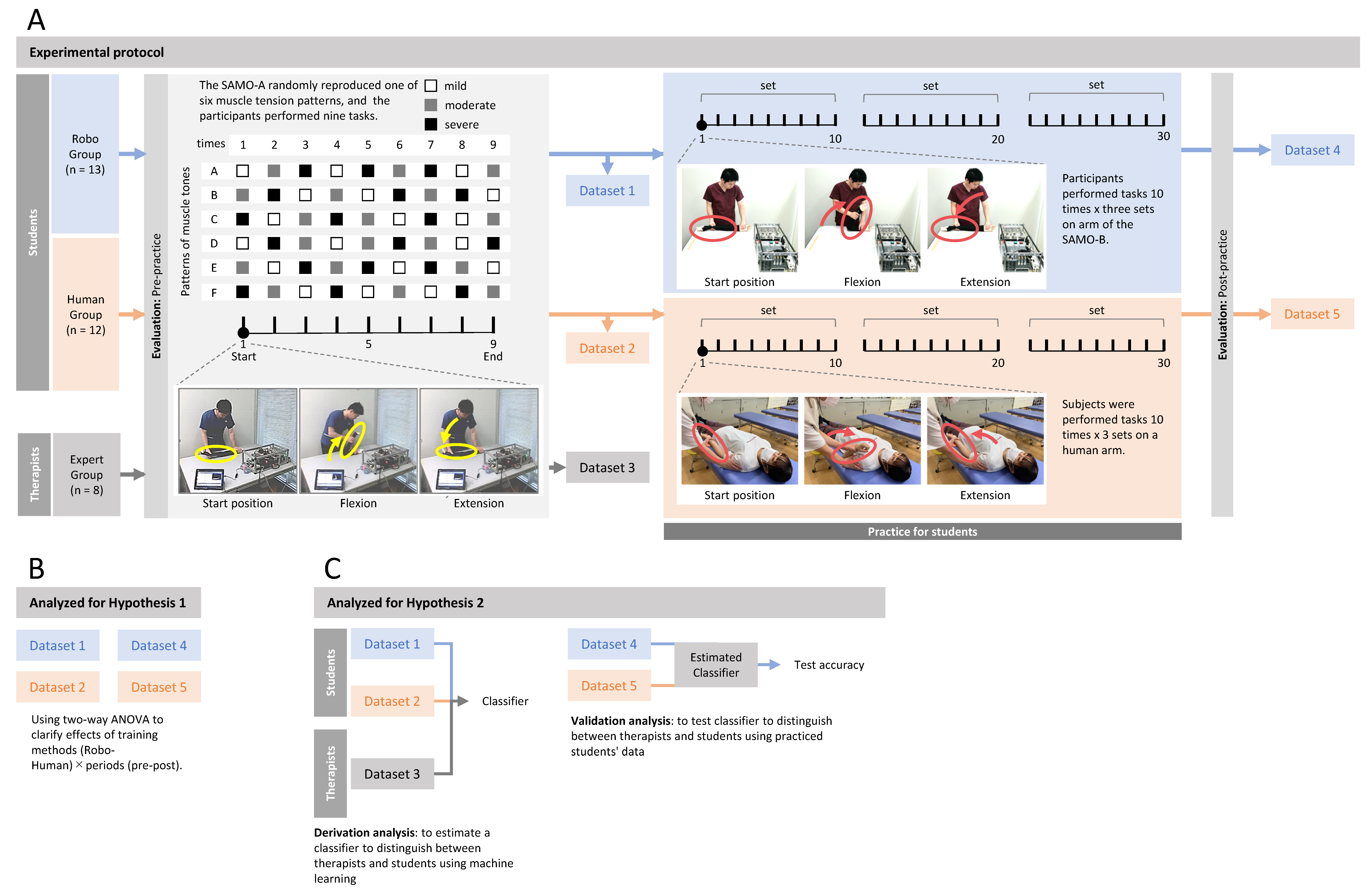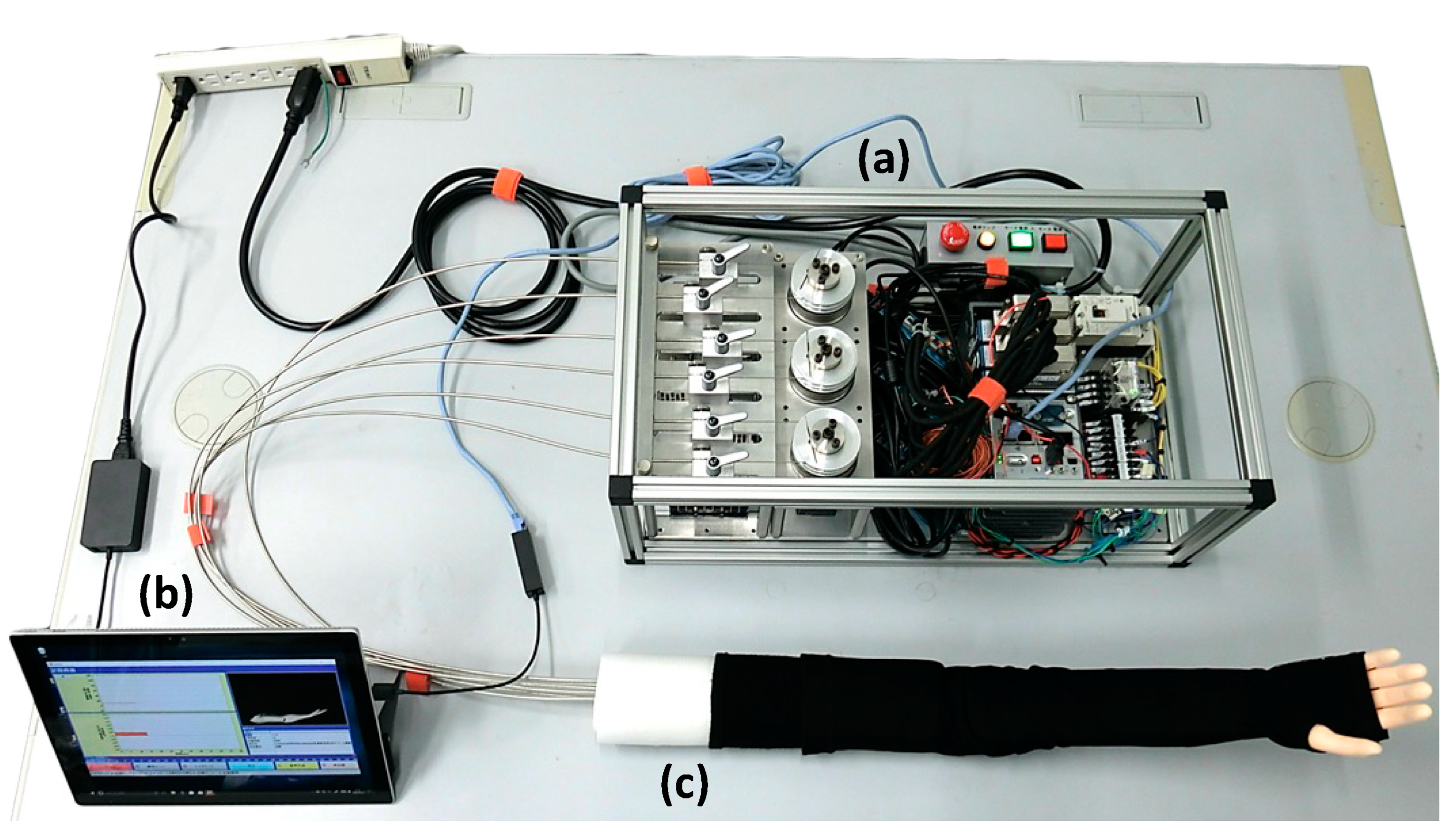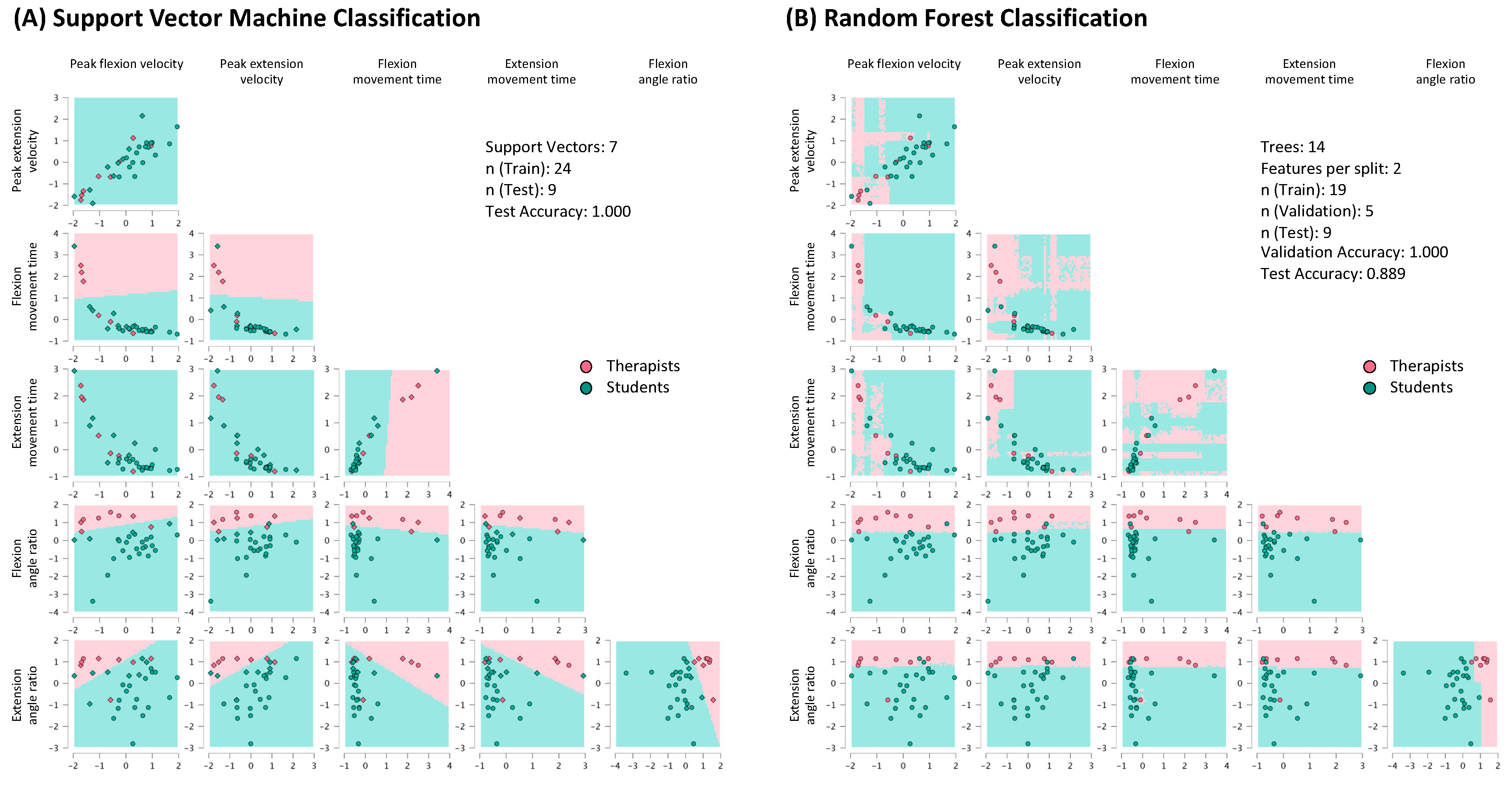Comparisons of Learning Effectiveness of Therapeutic Motion Techniques: Practicing with an Educational Hemiplegic Robot Arm versus Practicing with Other Students
Abstract
:Featured Application
Abstract
1. Introduction
2. Materials and Methods
2.1. Participants
2.2. Experimental Procedure
2.2.1. Movement Task
2.2.2. Therapeutic Motion Technique Practice
2.3. Statistical Analysis
2.3.1. Extraction of Feature Quantity and Analysis Method
2.3.2. Verification of Students’ Learning Effects through Practice of Therapeutic Motion Techniques
2.3.3. Statistics Software
3. Results
3.1. Participants
3.2. Comparison of Kinematics Data before and after Exercise Training in the Robo and Human Groups
3.3. Creation of Identifiers Using Machine Learning and Assessment of the Effect of Therapeutic Motion Technique
4. Discussion
5. Conclusions
6. Patents
Author Contributions
Funding
Institutional Review Board Statement
Informed Consent Statement
Data Availability Statement
Acknowledgments
Conflicts of Interest
Correction Statement
Abbreviations
| ANOVA | analysis of variance |
| JASP | Jeffreys’s Amazing Statistics Program |
| JSPS | Japan Society for the Promotion of Science |
| SAMO | Samothrace |
| SVM | support vector machine |
| RF | random forest |
References
- Koike, Y.; Suzuki, M.; Okino, A.; Takeda, K.; Takanami, Y.; Hamaguchi, T. Differences in manual exercise therapy skills between students and therapists. J. Ergon. Technol. 2019, 19, 35–44. [Google Scholar]
- Hodgetts, S.; Hollis, V.; Triska, O.; Dennis, S.; Madill, H.; Taylor, E. Occupational therapy students’ and graduates’ satisfaction with professional education and preparedness for practice. Can. J. Occup. Ther. 2007, 74, 148–160. [Google Scholar] [CrossRef] [PubMed]
- Tanzawa, T.; Futaki, K.; Kurabayashi, H.; Goto, K.; Yoshihama, Y.; Hasegawa, T.; Yamamoto, M.; Inoue, M.; Miyazaki, T.; Maki, K. Medical emergency education using a robot patient in a dental setting. Eur. J. Dent. Educ. 2013, 17, e114–e119. [Google Scholar] [CrossRef]
- Takanobu, H.; Takanishi, A.; Ozawa, D.; Ohtsuki, K.; Ohnishi, M.; Okino, A. Integrated dental robot system for mouth opening and closing training. In Proceedings of the 2002 IEEE International Conference on Robotics and Automation, Washington, DC, USA, 11–15 May 2002; pp. 1428–1433. [Google Scholar] [CrossRef]
- Koike, Y.; Suzuki, M.; Okino, A.; Takeda, K.; Takanami, Y.; Hamaguchi, T. Distinction of students and expert therapists based on therapeutic motions on a robotic device using support vector machine. J. Med. Biol. Eng. 2020, 40, 790–797. [Google Scholar] [CrossRef]
- Escalon, M.X.; Raum, G.; Francio, V.T.; Eubanks, J.E.; Verduzco-Gutierrez, M. The immediate impact of the coronavirus pandemic and resulting adaptations in physical medicine and rehabilitation medical education and practice. Pm R 2020, 12, 1015–1023. [Google Scholar] [CrossRef] [PubMed]
- Japanese Association of Occupational Therapists. JAOT Post-Qualification Education System. Available online: https://www.jaot.or.jp/en/activities/ (accessed on 12 August 2022).
- Ministry of Health. Labour and Welfare. Available online: https://www.mhlw.go.jp/file/05-Shingikai-10803000-Iseikyoku-Ijika/0000197493.pdf (accessed on 12 August 2022). (In Japanese).
- Japanese Association of Occupational Therapists. Available online: https://www.jaot.or.jp/files/shishin2018.tebiki2022.pdf (accessed on 12 August 2022). (In Japanese).
- Faul, F.; Erdfelder, E.; Lang, A.G.; Buchner, A. G*Power 3: A flexible statistical power analysis program for the social, behavioral, and biomedical sciences. Behav. Res. Methods 2007, 39, 175–191. [Google Scholar] [CrossRef] [PubMed]
- Faul, F.; Erdfelder, E.; Buchner, A.; Lang, A.G. Statistical power analyses using G*Power 3.1: Tests for correlation and regression analyses. Behav. Res. Methods 2009, 41, 1149–1160. [Google Scholar] [CrossRef] [PubMed]
- Koike, Y.; Okino, A.; Takeda, K.; Takanami, Y.; Hamaguchi, T. Comparison of manipulative indicators of students and therapists using a robotic arm: A feasibility study. Appl. Sci. 2021, 11, 9403. [Google Scholar] [CrossRef]
- Davatzikos, C.; Ruparel, K.; Fan, Y.; Shen, D.G.; Acharyya, M.; Loughead, J.W.; Gur, R.C.; Langleben, D.D. Classifying spatial patterns of brain activity with machine learning methods: Application to lie detection. Neuroimage 2005, 28, 663–668. [Google Scholar] [CrossRef] [PubMed]
- Mohammadpoory, Z.; Nasrolahzadeh, M.; Haddadnia, J. Epileptic seizure detection in EEGs signals based on the weighted visibility graph entropy. Seizure 2017, 50, 202–208. [Google Scholar] [CrossRef] [PubMed]
- JASP Team. JASP. 0.16.3. 2022. Available online: https://jasp-stats.org/ (accessed on 4 September 2024).
- Lance, J.W. Spasticity: Disordered motor control. In Symposium Synopsis; Feldman, R., Young, R., Koells, W., Eds.; Yearbook Medical Publishers: Chicago, IL, USA, 1980; pp. 487–489. [Google Scholar]
- Olenchak, F.R. Lessons learned from gifted children about differentiation. Teach. Educ. 2010, 36, 185–198. [Google Scholar] [CrossRef]
- Tomlinson, C.A. Mapping a route toward differentiated instruction. Educ. Leadersh. 1999, 57, 12–16. [Google Scholar]
- Zachry, T.; Wulf, G.; Mercer, J.; Bezodis, N. Increased movement accuracy and reduced EMG activity as the result of adopting an external focus of attention. Brain Res. Bull. 2005, 67, 304–309. [Google Scholar] [CrossRef] [PubMed]
- Marchant, D.C.; Clough, P.J.; Crawshaw, M. The effects of attentional focusing strategies on novice dart throwing performance and their task experiences. Int. J. Sport Exerc. Psychol. 2007, 5, 291–303. [Google Scholar] [CrossRef]
- Wulf, G.; Su, J. An external focus of attention enhances golf shot accuracy in beginners and experts. Research Q. Exerc. Sport 2007, 78, 384–389. [Google Scholar] [CrossRef] [PubMed]
- Wulf, G.; McConnel, N.; Gartner, M.; Schwarz, A. Enhancing the learning of sport skills through external-focus feedback. J. Mot. Behav. 2002, 34, 171–182. [Google Scholar] [CrossRef] [PubMed]
- Kok, C.L.; Ho, C.K.; Teo, T.H.; Kato, K.; Koh, Y.Y. A novel implementation of a social robot for sustainable human engagement in homecare services. Sensors 2024, 24, 4466. [Google Scholar] [CrossRef] [PubMed]




| Therapists (n = 8) | Students (n = 25) | ||
|---|---|---|---|
| Robo (n = 13) | Human (n = 12) | ||
| Age (years) | 35.9 ± 7.1 | 21.9 ± 0.5 | 22.0 ± 0.7 |
| Sex (male/female) | 7/1 | 5/8 | 4/8 |
| Years of registration | 12.0 ± 3.7 | 0.0 ± 0.0 | 0.0 ± 0.0 |
| Variables | Robo (n = 13) | Human (n = 12) | Repeated Measures of ANOVA | |||||||||||||
|---|---|---|---|---|---|---|---|---|---|---|---|---|---|---|---|---|
| Pre | Post | Pre | Post | Main Effect of Practice Group | Main Effect of Intervention | Inter Action | ||||||||||
| df1 | df2 | F | p | η | df1 | df2 | F | p | η | p | ||||||
| Flexion | Peak velocity (deg/s) | 101.0 ± 53.4 | 90.2 ± 37.3 | 107.2 ± 23.7 | 97.4 ± 30.5 | 1 | 23 | 0.219 | 0.644 | 0.008 | 1 | 23 | 3.77 | 0.064 | 0.019 | 0.926 |
| Peak angle ratio (%) | 84.4 ± 12.7 | 88.4 ± 5.1 | 83.9 ± 7.1 | 84.4 ± 11.3 | 1 | 23 | 0.432 | 0.517 | 0.014 | 1 | 23 | 1.66 | 0.211 | 0.014 | 0.317 | |
| Movement time (s) | 6.4 ± 6.3 | 6.3 ± 4.2 | 4.1 ± 1.0 | 5.0 ± 2.6 | 1 | 23 | 1.37 | 0.254 | 0.050 | 1 | 23 | 0.78 | 0.386 | 0.003 | 0.342 | |
| Extension | Peak velocity (deg/s) | 80.9 ± 19.2 | 76.0 ± 33.9 | 88.2 ± 19.2 | 83.7 ± 25.5 | 1 | 23 | 0.413 | 0.527 | 0.015 | 1 | 23 | 0.99 | 0.331 | 0.006 | 0.962 |
| Peak angle ratio (%) | 97.1 ± 2.2 | 98.3 ± 2.2 | 96.2 ± 2.5 | 96.7 ± 2.7 | 1 | 23 | 1.94 | 0.177 | 0.068 | 1 | 23 | 6.39 | 0.019 * | 0.027 | 0.235 | |
| Movement time (s) | 9.0 ± 6.1 | 9.5 ± 5.6 | 6.4 ± 2.1 | 7.3 ± 4.7 | 1 | 23 | 1.64 | 0.213 | 0.058 | 1 | 23 | 0.95 | 0.341 | 0.005 | 0.792 | |
| Robo (n = 13) | Human (n = 12) | Χ2 | p | |
|---|---|---|---|---|
| Support Vector Machine | 5 (38.5%) | 0 (0.0%) | 5.769 | 0.016 |
| Random Forest | 7 (53.8%) | 0 (0.0%) | 8.974 | 0.003 |
Disclaimer/Publisher’s Note: The statements, opinions and data contained in all publications are solely those of the individual author(s) and contributor(s) and not of MDPI and/or the editor(s). MDPI and/or the editor(s) disclaim responsibility for any injury to people or property resulting from any ideas, methods, instructions or products referred to in the content. |
© 2024 by the authors. Licensee MDPI, Basel, Switzerland. This article is an open access article distributed under the terms and conditions of the Creative Commons Attribution (CC BY) license (https://creativecommons.org/licenses/by/4.0/).
Share and Cite
Koike, Y.; Okino, A.; Takanami, Y.; Hamaguchi, T. Comparisons of Learning Effectiveness of Therapeutic Motion Techniques: Practicing with an Educational Hemiplegic Robot Arm versus Practicing with Other Students. Appl. Sci. 2024, 14, 8498. https://doi.org/10.3390/app14188498
Koike Y, Okino A, Takanami Y, Hamaguchi T. Comparisons of Learning Effectiveness of Therapeutic Motion Techniques: Practicing with an Educational Hemiplegic Robot Arm versus Practicing with Other Students. Applied Sciences. 2024; 14(18):8498. https://doi.org/10.3390/app14188498
Chicago/Turabian StyleKoike, Yuji, Akihisa Okino, Yasuhiro Takanami, and Toyohiro Hamaguchi. 2024. "Comparisons of Learning Effectiveness of Therapeutic Motion Techniques: Practicing with an Educational Hemiplegic Robot Arm versus Practicing with Other Students" Applied Sciences 14, no. 18: 8498. https://doi.org/10.3390/app14188498
APA StyleKoike, Y., Okino, A., Takanami, Y., & Hamaguchi, T. (2024). Comparisons of Learning Effectiveness of Therapeutic Motion Techniques: Practicing with an Educational Hemiplegic Robot Arm versus Practicing with Other Students. Applied Sciences, 14(18), 8498. https://doi.org/10.3390/app14188498






